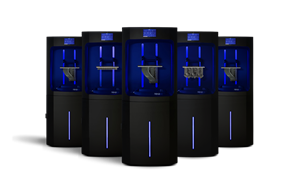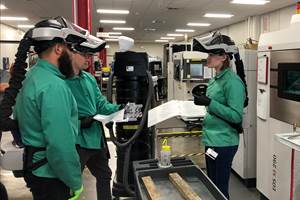Video: Advice to Manufacturers Getting Ready to Start in Additive
“It can be daunting,” says GE’s Greg Morris. “You have to make some tough decisions while things are not going well.” And yet, as he looks to the future of additive manufacturing, he says, “There is probably going to be a shortage of supply, not demand.”
Share
GE’s Greg Morris is a former additive manufacturing business owner who joined the group that is now GE Additive when his companies were acquired by GE. As he notes below, he thought he was late to the table in additive manufacturing when he began with it back in 1994. He wasn’t, of course, and companies seeing the value in embracing additive now need not feel that they are late to the table, either. I asked him what advice he has for the manufacturers beginning with additive today. His answer follows multiple different threads, speaking to both the challenge and the opportunity. Watch the video or read the transcript below.
Transcript:
Peter Zelinski, Additive Manufacturing
Reaching back to the time when you were an independent business owner, what perspective can you bring and what sort of insight or advice can you offer to the independent manufacturer who maybe is investing in additive, maybe is growing some ability in that capability, but they're faced with the challenge needing customers who are willing to engineer parts that can really take advantage of what additive can do.
Greg Morris, GE Additive
For the smaller businesses or the businesses getting involved in it, I think you have to find the niche that fits best for your business. You know, not all sizes are going to fit everybody and you saw again, from a few of the slides, there are a ton of different modalities, a ton of different ways you can leverage and use the technology. It can be as simple as “I want to use it internally for efficiencies of fixturing” or what have you, or tooling. Or it could be more complex, where I'm going to go get a modality or I'm going to buy additive, buy into additive. I'm going to go out to my customer base and I'm going to say I've expanded my capabilities and now I've got additive as well. And look, it's not easy. I think those who jump into the game of additive—and it depends on what modality and what materials—but it can be challenging. And if you deal, for instance, with a GE Aviation, there's a lot of potential coming. But to become an additive supplier for the aviation industry, the bar is pretty high. It's high not just in your knowledge of how do you operate the machines, but you have to have a lot of things in place from a certification standpoint, from a process standpoint, from a knowledge standpoint, in order to really be effective as a production supplier to say GE Aviation for gas turbine engine components. So, a pretty high bar.
Same thing with implants. You're going to have a different type of sequence of events you have to go through, and certifications, but that bar is pretty high. There are industries that are not as high of a bar and that was touched on as well. But I think for the smaller companies, there are a lot of ways to enter. It doesn't have to be that I put all my chips on the table and, admittedly, these are pretty expensive machines. You think about half a million dollars or a million-dollar machine. I can go buy two to five lathes and mills and keep going with my traditional technologies and probably do well. So it's got to be a purposeful decision. I would also say I think you have to be very committed. So it's very easy as a traditional manufacturer to get involved in new technology, find out it gets tough, and when it gets tough you fall back on what you know. To really cut that cycle, you have to make some tough decisions while things are not going well because that's where you learn.
Peter Zelinski
You have to remain committed: I'd love to hear you elaborate on that a little bit more. Maybe there's somebody sitting in the audience who is an established, successful conventional manufacturer. They're in plastics, they're in metalworking. But they get it, and they're persuaded that big changes are coming as a result of additive. They think, I have to invest in this and develop this. I have to get some capability here. What is the path going to look like for them? What are some potential challenges for them? What advice can you offer as far as what it really looks like to stay committed to this technology?
Greg Morris
So first I would say it can be daunting. It can be something you look at and say, “There's a lot of learning. I feel like there's a ton of people that are way ahead of me.” I think just having this kind of an event is very helpful. I think you can tap into a number of resources, so you don't have to jump in necessarily with going out and acquiring that piece of equipment that's very expensive. You can take your learning curve in a controlled way. You can tap into, say, Oak Ridge National Labs, and their center that is a beautiful place to be able to go, or some of the other type of institutes that are around the country or around the world for that matter. There are service providers that are people that have the equipment, they have the knowledge, and I think this industry—one of the things that's pretty neat about it is other people are willing to share; they're willing to talk about their capability and help people come up to speed.
And if you believe, again, $7 billion today and say $70 or $80 billion in 10 years, there's a lot of room for a lot of people and there's going to be probably a shortage of supply, not a shortage of demand. If you believe those numbers. So, my point being: This is an industry that historically has been pretty welcoming and pulling people along and trying to help them understand how you come up to speed on the technology. Whether it's through trade shows, service providers, institutes like Oak Ridge, etc. If you choose to go this route, it is a choice. You know nobody is saying that the business one is in is bad, and again, I would suggest that if you have a very successful business in traditional manufacturing, it's not going away. You're probably going to find that your business is great, it’s thriving and growing. Additive might just be a means to broaden the offering, broaden the capability, and hedge against what maybe some of your OEM customers might start to do with the technology. There's nothing wrong with a wait-and-see attitude because there are so many modalities and there are so many different technologies that are coming along and that are maturing and developing. So, I don't think there should be an urgency. You know, ironically, I felt in 1994 like we were too late to the game and everybody was involved in additive. You know, flash-forward 23, 24 years and I realize that was an irrational fear and I'm glad we got involved when we did, but I don't think I had to feel like we were already too late and I would encourage people not to feel like they're too late. Start to experiment, start to see how you can affect your own business in a positive way, and then see strategically where are the opportunities that your business can go. And I think spending the time to really think strategically versus tactically is going to be pretty important as one determines where do they want to jump in, how do they want to jump in, and how committed are they going to be.
Peter Zelinski
So that's an interesting tension I'm hearing you articulate, because you seem to have said earlier that this technology is undoubtedly significant and deserves your attention and engagement, but you're also saying there's no need to panic about it and there's no need to rush. Am I being fair?
Greg Morris
You're calling me out. Yeah, I think you're being fair. I'm saying both things. Again, 0.03 percent—I'm just going to use my numbers back again: [Additive is] 0.03 percent of total global manufacturing output. If it got to half a percent, that's a really big number. It's still half a percent and 99.5 percent is still traditional as we think about it. So, every business has to make the decision about whether they feel that there is a threat to their current existing way of doing business or their technologies they use, and then on the other side of the coin is the opportunity, and maybe additive is a way to substantially grow their business. Maybe it is a way to incrementally grow it.
So yes, there is huge opportunity, but I also am sensitive to the fact that I think a radical left turn on your business is not maybe the right answer. I think sometimes taking the appropriate amount of time to evaluate and really see what impact does this have, and do it with an open mind. If one goes into it where “I'm going to prove this additive stuff’s a bunch of crap and I don't need to get involved in it,” yeah, you're probably going to find that it’s a bunch of crap. But if you if you approach it with a viewpoint of “I'm curious and I wonder how this might affect me, negative or positive, and I should be aware of it,” then I think that's the appropriate way to approach it for those who are not currently involved. There are just so many mechanisms to get more involved and to learn more and my encouragement is learn more. Find out what others in your industry are doing. Find out what your competitors are doing, find out what your customers are doing in the space, and then learn more through trade shows and a bunch of other avenues. And I think that will ultimately lead one to strategically where do I take the business. And again, I can't emphasize enough, I think it’s strategic—not necessarily a tactical decision all the time.
Related Content
AM 101: What Is Binder Jetting? (Includes Video)
Binder jetting requires no support structures, is accurate and repeatable, and is said to eliminate dimensional distortion problems common in some high-heat 3D technologies. Here is a look at how binder jetting works and its benefits for additive manufacturing.
Read MoreHow to Improve Polymer AM Productivity 20X
A fast cycle time is critical to efficient production 3D printing, but it’s not the only thing. How you choose the right parts for AM, prepare jobs for production, and manage post processing will have just as big an impact on total 3D printing throughput. It all needs to work together to achieve maximum productivity.
Read MoreAM 101: What is Ultrasonic Additive Manufacturing?
Going from additive to subtractive can be simple with Ultrasonic Additive Manufacturing (UAM). What is it and how does it work? Learn the basics in this 101 post.
Read MoreHow to Pursue a Career in Additive Manufacturing
AM professionals are in demand as 3D printing matures and advances. But what skills are hiring manufacturers looking for? How can applicants prepare? And where can you find relevant job listings?
Read MoreRead Next
3D Printing Brings Sustainability, Accessibility to Glass Manufacturing
Australian startup Maple Glass Printing has developed a process for extruding glass into artwork, lab implements and architectural elements. Along the way, the company has also found more efficient ways of recycling this material.
Read MoreAt General Atomics, Do Unmanned Aerial Systems Reveal the Future of Aircraft Manufacturing?
The maker of the Predator and SkyGuardian remote aircraft can implement additive manufacturing more rapidly and widely than the makers of other types of planes. The role of 3D printing in current and future UAS components hints at how far AM can go to save cost and time in aircraft production and design.
Read MoreHybrid Additive Manufacturing Machine Tools Continue to Make Gains (Includes Video)
The hybrid machine tool is an idea that continues to advance. Two important developments of recent years expand the possibilities for this platform.
Read More




















